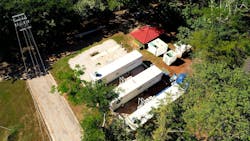About the author: Yolanda Padilla is regional manager for Fluence Corp. Padilla can be reached at [email protected] or 212.572.5700.
When considering its decreasing access to freshwater due to drought and stressed aquifers, and its abundant access to seawater, this resort’s best option for a drinking water solution was clear.
In the Guanacaste Province of Costa Rica, located on Playa Conchal in Cabo Velas, Reserva Conchal is one of the most luxurious beach resorts in the country. The 2,300-acre property houses an all-inclusive five-star hotel, an 18-hole golf course, a spa and a residential real estate development, and is adjacent to a wildlife refuge. This refuge serves as a home to approximately 32 species of birds, 12 species of mammals, various reptiles and amphibians, and a wide range of local plant life, and is a draw for tourists to the region. The resort, which prides itself on being eco-friendly and touts its sustainable golf course and its use of solar energy, works hard to honor its commitment to what it feels is its obligation be a good neighbor to the refuge and make the best efforts to sustain and preserve it.
After several years of ongoing drought in the region, Reserva Conchal was faced with the challenge of securing a reliable source of drinking water to serve the resort and reduce its dependence on local aquifers, freeing up these resources for use by the local flora and fauna. In 2016, Reserva Conchal contacted Fluence Corp. to custom-design and install a desalination plant.
Dealing With Drought
Costa Rica’s tourism industry, already an approximately $2.8 billion industry employing more than 600,000 people in 2015, projected its record 2.66 million visitors to see a 14% increase for 2016, with the Bank of Costa Rica projecting a revenue increase to $3.1 billion by 2017. Guanacaste, plagued with one of the worst droughts in recorded history since 2014, was quickly exhausting its aquifers, increasing the salinity of local groundwater given the aquifer’s diminished ability to recharge. Combined with the lack of water infrastructure to transport water over long distances, this drought posed a threat not only to the business operations of the region, but also to local plants and wildlife, which were competing for these same resources. As demand from residents increased, potential repercussions to the economy required a quick and reliable solution with no negative impact to the surrounding environment.
An Attractive Option
The challenge of identifying a solution that could address Reserva Conchal’s need for high-quality drinking water, while focusing on its commitment to sustainability without disrupting the environment with unsightly or noisy installations, was also compounded by the urgency of the timeline. Fluence’s Nirobox SW, a containerized desalination system, met all the requirements. It could deliver the capacity and output quality required in a small footprint, with minimal infrastructure investment and no noise, while blending into the surroundings and without damaging the landscape. Additionally, its plug-and-play design meant it could be up and running within the tight timeline, with a fraction of the operation and maintenance cost as compared to traditional desalination plants with extensive planning and infrastructure requirements.
Containerized desalination systems were installed quickly to meet a tight timeline.
Water out of the Box
Reserva Conchal needed a solution with a high recovery rate that featured low energy consumption and required minimal use of chemicals, and a smart intake and discharge capability was needed to minimize impacts associated with intake suction, and to diffuse the brine as much as possible. Fluence utilized its experience with both containerized and custom-designed desalination to select the appropriate technologies to design and commission an installation of three Nirobox units with a total capacity of approximately 1,500 cu meters per day of potable water. The process flow treats a 35,000 ppm total dissolved solids seawater feed with disc filtration, ultrafiltration, reverse osmosis and remineralization to drinking water quality. The system was in operation eight months after it was ordered, and in advance of tourist season, to the satisfaction of Reserva Conchal.
With the system fully operational, Reserva Conchal has enough potable water to fully supply its operations, and the resort is able to operate at full occupancy even in the dry season. It can irrigate its golf course, supply water for swimming pools and provide service water throughout the development without relying on outside sources, and without the added cost of purchasing potable water. Beyond cost-savings, the eco-positive features and the independence this solution provided to the resort has been invaluable in the operation of the business.
